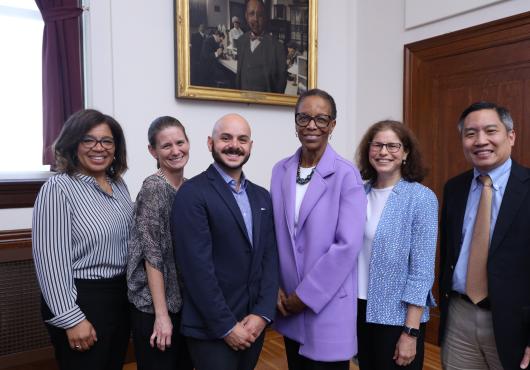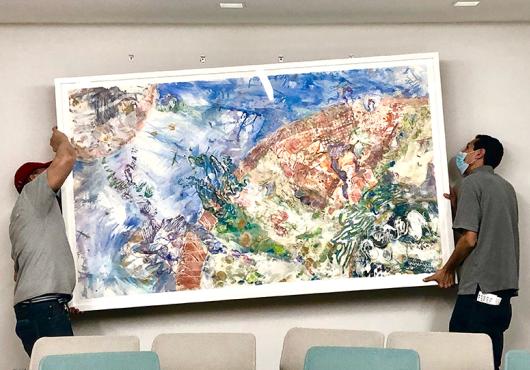If Dr. Alice Hamilton were to visit Harvard Medical School today she might have a difficult time believing there is now a bust commemorating her and her work on prominent display.
But on Sept. 26, HMS Dean George Q. Daley, with some fanfare, unveiled a bust of Hamilton in the Tosteson Medical Education Center atrium, a hub for HMS students.
“By placing her likeness here, at perhaps the most visible point in the student center … we are taking the first step of an initiative to refresh imagery and artwork at HMS,” Daley told the crowd of students, faculty and staff who gathered for the unveiling.
“We will evolve our art so that it inspires and celebrates our great diversity, while paying homage to our past. We are committed to recognizing Alice and others who have contributed so much to our school and to the world, and who have been underrepresented in what we display in our halls,” Daley said.
When Hamilton accepted a faculty position as assistant professor of industrial medicine at HMS in 1919, she became the first woman to be appointed to the Harvard faculty more than 280 years after the School was founded. A pioneer in the field of toxicology, she was an expert in industrial and occupational health, a discipline she was instrumental in establishing. For her work in this area, she became the first woman to receive a Lasker prize.
But Hamilton was still female, at a school where women had not yet been admitted as students, and as such she was permitted on the faculty with certain stipulations: she must not enter the Faculty Club, march in the Commencement procession or take a seat on the Commencement platform. (See related Harvard Medicine magazine story.)
Now, her sculpture stands as a statement that the School values inclusivity and diversity among its faculty, students and staff, and celebrates the contributions of all its illustrious faculty members.
“She never stopped fighting for peace and was a staunch advocate for social justice,” Daley said of Hamilton. “She gives us perspective on how much work is left to be done. She teaches us that we can do better and that the status quo just isn’t good enough.”
The Hamilton bust was commissioned after students had a conversation with faculty member Trudy Van Houten, an HMS lecturer on radiology at Brigham and Women’s Hospital, about the busts of legendary male faculty members populating the atrium, questioning why there were no females represented among them.
“The stories that we tell are always a choice of the community, even here,” said HMS student Jon Kusner at the unveiling. “And these stories shape how we identify with an institution and its history. And perhaps more powerfully, these stories change the identity of an institution.”
To that end, with the help of the HMS Aesculapian Club and the Countway Library Center for the History of Medicine, the School commissioned sculptor Robert Shure of Skylight Studios to create a bust of Hamilton.
Van Houten watched the unveiling with students who took a break from their anatomy class for the occasion.
“It reminds me of what an honor it is to work with Harvard Medical School students, particularly at a moment like this, and what an important part of the community they are,” Van Houten said.
Faculty member Sabine Hildebrandt, an HMS associate professor of pediatrics at Boston Children’s Hospital and a lecturer on global health and social medicine, said it was “high time” a female physician and scientist was represented among the School’s artwork.
“I think we have more than 50 percent female students and they are teaching us what is needed for the next generation,” Hildebrandt said.
For the students dressed in scrubs who shot videos and photos with their phones and clapped loudly at the unveiling, the sculpture seemed to serve as an affirmation from the School that they too will make meaningful contributions to medicine and science and be recognized for them.
“Dean Daley has given this message to us that he wants to see our faces on the walls too,” said London Society student Nicole Gilette.
Eleanor Shore, HMS ’55, one of the School’s early women graduates and a former HMS dean for faculty affairs, attended the unveiling with husband Miles, HMS ’54, the Bullard Professor of Psychiatry, Emeritus. The Shores initiated a 50th Anniversary Fellowship Program for Scholars in Medicine to promote gender equity in career development and allow junior faculty to balance family life with professional responsibilities.
“We’re now recognizing the contributions women have made all along [at Harvard],” Miles Shore said after the unveiling.
Eleanor Shore said her own class was part of a 10-year trial to admit women that began at HMS in 1945. She said her female classmates would never have thought to ask the faculty for more representation in the classrooms, labs or halls.
“I just thought it was a miracle that we were here,” she said. “And if we didn’t work extra hard there would be no more women here.”
Daley said there will be more work done to refresh the imagery and artwork at HMS. The work will be guided by the Arts and Cultural Representation Committee, led by Nawal Nour, HMS associate professor of obstetrics, gynecology and reproductive biology at Brigham and Women’s, and Dean for Students Fidencio Saldaña, and composed of faculty, students and staff.
“I know there are many perspectives about how we treat certain imagery,” Daley said. “I do ask for your patience as we move forward … I recognize that it will take time to get this right and to have a thoughtful process that includes the entire HMS community.”





